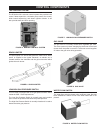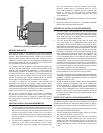
21
GENERAL REQUIREMENTS
REQUIRED ABILITY
Installation or service of this boiler requires ability equivalent to
that of a licensed trades man in the eld involved. Plumbing, air
supply, venting, gas supply, and electrical work are re quired.
LOCATION
When installing the boiler, consideration must be given to proper
location. The location selected should provide ade quate air
supply and be as centralized with the piping system as possible.
This boiler is intended for Indoor Installation only, and should not
be installed where freezing temperatures or any moisture could
damage the external components of the boiler.
REPLACING EXISTING COMMON VENTED BOILER
NOTE: This section does not describe a method for common
venting XP units. It describes what must be done when a unit
is removed from a common vent system. The XP units require
special vent systems and fans for common vent. Contact the
factory if you have questions about common venting XP units.
When an existing boiler is removed from a common venting
system, the common venting system is likely to be too large
for proper venting of the appliances remaining connected to it.
At the time of removal of an existing boiler, the following steps
should be followed with each appliance remaining connected to
the common venting system placed in operation, while the other
appliances remaining connected to the common venting system
are not in operation.
1. Seal any unused openings in the common venting system.
2. Visually inspect the venting system for proper size and
horizontal pitch and determine there is no blockage or
restriction, leakage, corrosion and deciencies which could
cause an unsafe condition.
3. In so far as it is practical, close all building doors and
windows and all doors between the space in which the
appliances remaining connected to the common venting
system are located and other spaces of the building. Turn
on clothes dryers and any appliance not connected to the
common venting system. Turn on any exhaust fans, such as
range hoods and bathroom exhausts, so they will operate
at maximum speed. Do not operate a summer exhaust fan.
Close replace dampers.
4. Place in operation the appliance being inspected. Follow the
lighting instructions. Adjust thermostat so the appliance will
operate continuously.
5. Test for spillage at the draft hood relief opening after 5
minutes of main burner operation. Use the ame of a match
or candle, or smoke from a cigarette, cigar or pipe.
6. After it has been determined that each appliance remaining
connected to the common venting system properly vents
when tested as outlined above, return doors, windows,
exhaust fans, replace dampers and any other gas-burning
appliance to their previous condition of use.
7. Any improper operation of the common venting system
should be corrected so that the installation conforms with
the National Fuel Gas Code, ANSI Z223.1/NFPA 54 and/
or CSA B149.1, Installation Codes. When resizing any
portion of the common venting system, the common venting
system should be resized to approach the minimum size as
determined using the appropriate tables and guidelines in the
National Fuel Gas Code, ANSI Z223.1/NFPA 54 and/or CSA
B149.1, Installation Codes.


















